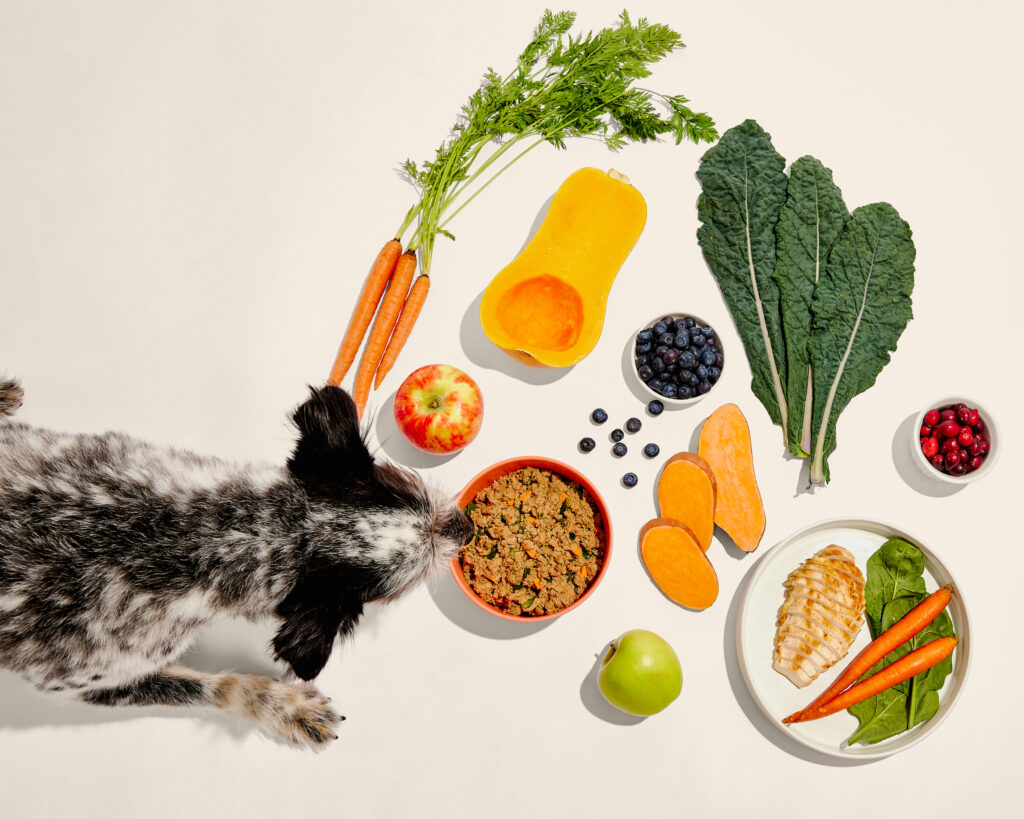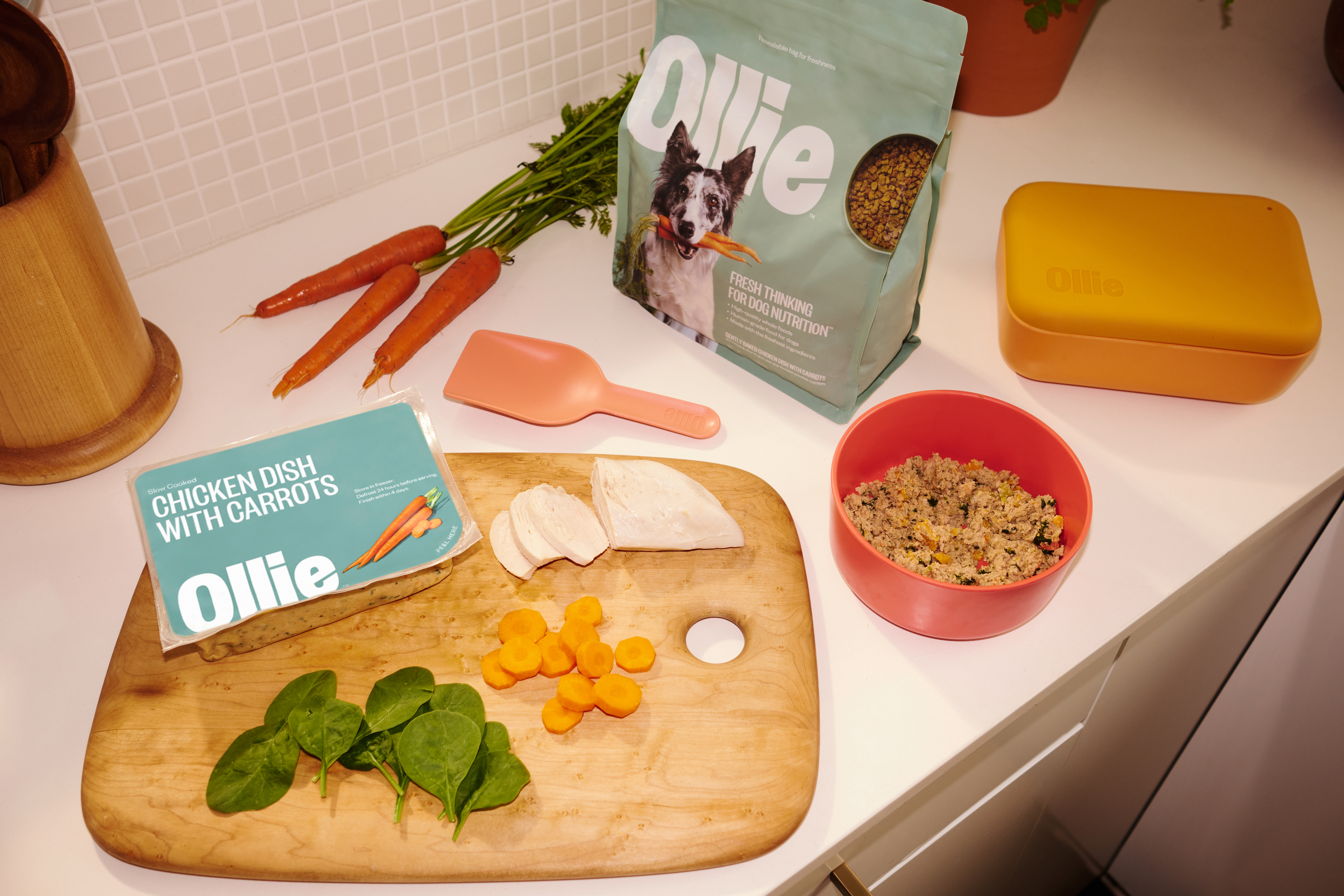Hey Ollie blog readers! We’re offering you an exclusive 60% OFF your starter box! Try now!
When it comes to caring for a dog with special dietary needs, finding the right nutrition can sometimes feel like solving a puzzle. Whether your dog has food sensitivities, allergies, or specific health conditions, their diet plays a crucial role in their overall wellbeing. In this article, we’re digging into fresh, human-grade dog food as a solution for dogs requiring specialized nutrition.
Understanding Special Dietary Needs in Dogs
Dogs, like humans, can develop various dietary sensitivities and health conditions that require specialized nutrition. These special needs might manifest in different ways, affecting your dog’s quality of life and overall health.
Common Special Dietary Needs
Food allergies and sensitivities are among the most common dietary challenges dogs face. These reactions occur when a dog’s immune system identifies certain food proteins as harmful, triggering uncomfortable symptoms. Dogs can be allergic to various ingredients, including certain proteins, grains, and additives found in many commercial dog foods.
Sensitive stomachs represent another common issue, with symptoms ranging from occasional upset to chronic digestive problems. Dogs with sensitive digestive systems often require easily digestible foods with high-quality ingredients to prevent gastrointestinal distress.
Some dogs also have specific health conditions that benefit from tailored nutrition:
- Weight management needs
- Kidney or liver conditions
- Diabetes
- Heart disease
- Joint issues
Recognizing Signs of Dietary Issues
- Persistent itching, scratching, or skin irritations
- Chronic ear infections
- Gastrointestinal issues like vomiting or diarrhea
- Excessive gas or bloating
- Changes in stool consistency
- Lethargy or decreased energy levels
If you notice these symptoms persisting, consulting with your veterinarian is essential before making dietary changes.

The Fresh Food Advantage for Special Diets
Fresh dog food offers significant benefits for dogs with special dietary needs, particularly when compared to highly processed commercial options.
Nutritional Integrity and Bioavailability
Fresh dog food preserves more nutrients through minimal processing. When ingredients are gently cooked at low temperatures in small batches, they retain more of their natural nutritional value[1]. This cooking method ensures maximum nutritional benefit while making the food safe to eat.
The bioavailability of nutrients—how efficiently your dog’s body can absorb and use them—is typically higher in fresh foods. This improved nutrient absorption is particularly valuable for dogs with digestive sensitivities or health conditions that affect nutrient processing.
Ingredient Transparency and Quality
Human-grade ingredients provide a significant advantage for dogs with special dietary needs. These premium ingredients must meet the same safety and quality standards as food produced for human consumption[2]. This higher standard means fewer contaminants, better quality control, and ultimately, a safer option for sensitive dogs.
With fresh dog food, you can clearly identify what your dog is eating. The whole, recognizable ingredients make it easier to pinpoint and avoid specific allergens or sensitivities. This transparency is invaluable when managing food allergies or intolerances.
Customization Possibilities
Perhaps the most significant advantage of fresh dog food for special diets is the ability to customize recipes. Fresh food providers can often tailor portions and ingredients to address specific health concerns, creating truly personalized nutrition plans for dogs with special needs.
Key Ingredients for Common Canine Dietary Challenges
Selecting the right ingredients is crucial when addressing specific dietary needs. Here’s how certain ingredients can help with common issues:
For Food Allergies and Sensitivities
Novel proteins can be game-changers for dogs with food allergies. These are protein sources your dog hasn’t been exposed to before, reducing the likelihood of an allergic reaction. Options might include turkey, lamb, or even more unique proteins.
Limited-ingredient diets simplify food choices by using fewer components, making it easier to identify and avoid allergens. These diets typically feature a single protein source and limited additional ingredients.

For Digestive Issues
Easily digestible proteins like chicken and turkey are often well-tolerated by dogs with sensitive stomachs. These lean proteins provide essential amino acids without overwhelming the digestive system.
Fiber-rich vegetables support healthy digestion by regulating gastrointestinal transit time and promoting beneficial gut bacteria. Sweet potatoes, pumpkin, and certain leafy greens can be particularly beneficial for digestive health.
Healthy fats from sources like fish oil provide omega-3 fatty acids that help reduce inflammation throughout the body, including the digestive tract. These fats also support skin health, which can be beneficial for dogs with food-related skin issues.
Fresh Food Solutions: Comparing Options
When considering fresh food for your dog’s special diet, it’s important to understand how different options compare. Fresh dog food typically falls into several categories, each with distinct characteristics that may better suit certain dietary needs.
Types of Fresh Dog Food Options
| Feature | Fresh-Cooked | Gently Cooked | Raw | Home-Cooked |
| Processing | Cooked at higher temperatures | Slow-cooked at low temperatures | Uncooked | Varies by recipe |
| Nutrient Retention | Good | Excellent | Highest | Varies |
| Safety | Very safe | Very safe | Potential pathogen risk | Depends on preparation |
| Convenience | High | High | Medium | Low |
| Customization | Limited | Often available | Limited | Complete |
| Suitability for Allergies | Good | Excellent | Good | Excellent |
Gently cooked fresh food, like that offered by Ollie, provides an excellent balance of safety, nutrition, and convenience for dogs with special dietary needs. The slow-cooking process at low temperatures preserves nutrients while eliminating harmful bacteria, making it an ideal choice for dogs with compromised immune systems or digestive issues[1].
What to Look For in Fresh Dog Food
- Complete and balanced nutrition formulated to meet AAFCO standards
- Transparency about ingredient sourcing and quality
- Options that avoid your dog’s specific allergens or trigger foods
- Portion control appropriate for your dog’s size, age, and activity level
Ollie’s fresh dog food meets these criteria with recipes formulated to meet the nutritional levels established by the AAFCO Dog Food Nutrient Profiles for All Life Stages[3]. Their human-grade ingredients and careful sourcing provide the quality assurance needed for dogs with special dietary requirements.

Transitioning to a Fresh Food Diet
Switching to fresh food requires a thoughtful approach, especially for dogs with sensitive systems.
Creating a Transition Plan
A gradual transition is key to success when introducing fresh food. Start by mixing a small amount of fresh food with your dog’s current diet, then slowly increase the proportion of fresh food over 7-10 days. This gradual change helps prevent digestive upset and allows your dog’s system to adjust.
For dogs with particularly sensitive stomachs or severe allergies, an even slower transition might be necessary. In these cases, consider extending the transition period to 2-3 weeks, increasing the fresh food proportion in smaller increments.
Monitoring Your Dog’s Response
During the transition period, carefully observe your dog for any changes in:
- Stool quality and consistency
- Energy levels
- Skin and coat condition
- Appetite and interest in food
- Allergy symptoms or digestive discomfort
Keep a simple food journal during this time, noting what your dog eats and any reactions. This information can be invaluable if adjustments are needed or when discussing progress with your veterinarian.
The Science Behind Fresh Nutrition for Special Needs
The benefits of fresh food for dogs with special dietary needs are supported by nutritional science and veterinary research.
Nutritional Completeness and Balance
Fresh dog food from quality providers is formulated to meet the nutritional levels established by the AAFCO Dog Food Nutrient Profiles[3]. This ensures that dogs receive complete and balanced nutrition, even when certain ingredients must be avoided due to allergies or sensitivities.
Ollie’s recipes, for example, are formulated for all life stages, providing balanced, science-led nutrition that supports dogs from puppyhood through their senior years[1]. This nutritional completeness is essential for dogs with special dietary needs, who might otherwise risk nutritional deficiencies when certain foods are eliminated.
Minimal Processing Benefits
The minimal processing of fresh dog food preserves more of the natural nutrients in the ingredients. Fresh food is typically cooked at lower temperatures than highly processed kibble, which can destroy heat-sensitive vitamins and alter protein structures[1].
For dogs with food sensitivities, these less-altered proteins may be less likely to trigger immune responses. Additionally, the higher moisture content in fresh food supports hydration and kidney health, which can be particularly beneficial for dogs with certain medical conditions.

Practical Considerations for Special Diet Management
Managing a special diet for your dog involves more than just choosing the right food. Consider these practical aspects to ensure success.
Cost and Convenience Factors
Fresh dog food typically costs more than conventional kibble, reflecting the higher quality ingredients and production methods. However, when weighing this cost, consider the potential savings on veterinary bills and medications that might be reduced when dietary issues are properly addressed.
Subscription services like Ollie offer convenience through regular deliveries of pre-portioned meals. This can simplify feeding and ensure consistency, which is particularly important for dogs with sensitive systems that react to dietary changes.
Working with Veterinary Professionals
Partnering with your veterinarian is essential when managing a dog with special dietary needs. Before making significant changes to your dog’s diet, consult with your vet, especially if your dog has diagnosed medical conditions.
In some cases, your veterinarian might recommend working with a veterinary nutritionist who specializes in creating custom diet plans for dogs with complex medical needs. These specialists can help ensure that all nutritional requirements are met while addressing specific health concerns.
Frequently Asked Questions
How do I know if my dog needs a special diet?
Signs that your dog might benefit from a special diet include persistent digestive issues, itchy skin, ear infections, excessive gas, or chronic diarrhea. If you notice these symptoms, consult with your veterinarian for proper diagnosis before changing your dog’s diet.
Can fresh food help with my dog’s allergies?
Fresh food can be beneficial for dogs with allergies because it typically contains fewer preservatives and additives that might trigger reactions. Additionally, fresh food providers often offer limited-ingredient recipes and novel proteins that can help manage food allergies. The high-quality, human-grade ingredients used in fresh food like Ollie’s recipes may also be less likely to contain contaminants that could trigger sensitivities[2].
Is fresh food appropriate for all dogs with special needs?
While fresh food is suitable for many dogs with special dietary requirements, some medical conditions may require very specific nutritional profiles. Always consult with your veterinarian before switching to fresh food, especially if your dog has kidney disease, liver problems, or other serious health conditions.
How long before I see improvements after switching to fresh food?
Many pet parents notice improvements within 2-4 weeks after transitioning to fresh food. Digestive issues often show the quickest response, while skin and coat changes may take longer. Keep in mind that every dog is unique, and response times can vary based on the specific condition and severity.
Can I mix fresh food with my dog’s current diet?
Yes, mixing fresh food with your dog’s current diet is an excellent way to transition gradually. It can also be a more economical approach if feeding 100% fresh food isn’t within your budget. Even supplementing with some fresh food can provide nutritional benefits for dogs with special needs.
By understanding your dog’s specific dietary requirements and choosing a high-quality, fresh food option like Ollie, you can help manage your dog’s special dietary needs while supporting their overall health and wellbeing. Remember that patience and consistency are key when implementing dietary changes, and working closely with veterinary professionals will help ensure the best outcomes for your dog.
Citations
Tagged As:

The nutrition your dog needs,
the food they want.

Enjoying our articles? Subscribe our Newsletters and get new articles directly to your inbox
You might also like
3 July 2025
5 MINS READ
How Fresh Food Can Help Your Dog Have Perfect Poops
As a pup parent, you’re likely very familiar with your dog’s bathroom habits. While it may not be the most glamorous part of taking care of your pup, a dog’s stool can be one of the most dir…
by Ollie Pets
3 July 2025
5 MINS READ
Understanding the Risks of Raw Dog Food
When it comes to choosing the right diet for your dog, understanding the full picture is crucial for making an informed decision. In this article, we’ll dig deeper into what defines a raw diet, …
by Ollie Pets
3 July 2025
4 MINS READ
Understanding a Balanced Diet for Your Dog
As a dedicated pet parent, you want to provide the best for your dog, and that starts with their food bowl. We all understand the basics of a balanced diet for ourselves, but what does that look l…
by Ollie Pets







